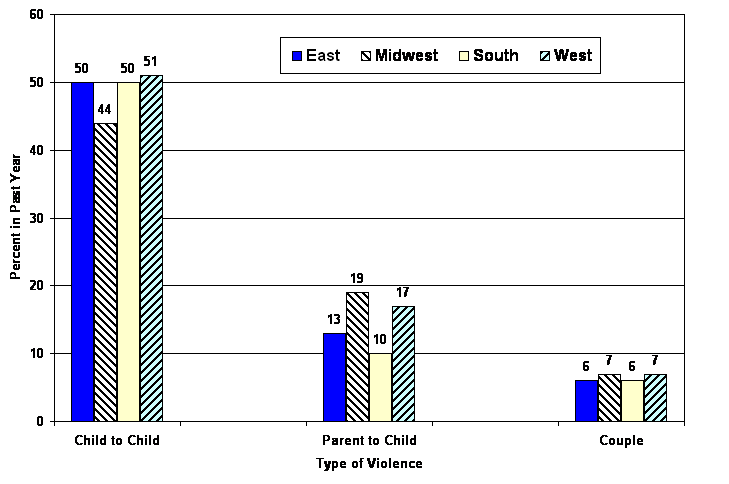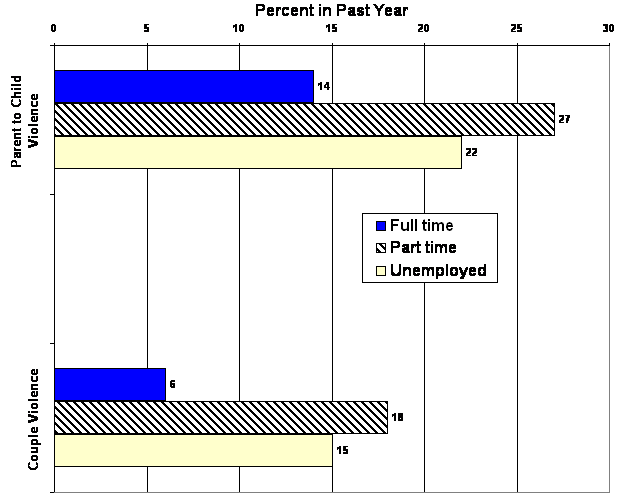Interpersonal Consequences
Part 1: Violence in the American Family
Background: A National Survey of Domestic Violence
 Behind Closed Doors: Violence
in the American Family, by Murray Straus and his colleagues, Richard
Gelles and Suzanne Steinmetz (Anchor Books: 1980), reports the results
of a landmark study of patterns of physical violence in U.S. families.
Straus et al. selected a probability sample of 2,143 married (or cohabiting)
couples and asked adults in each household a series of questions about
acts of violence they, their spouse, or their children had committed during
conflicts with other family members in the past year. To provide some background for examining the relationship between alcohol use and interpersonal violence, it will be helpful to focus on more general findings of this ground-breaking study of abusive violence in U.S. families.
Behind Closed Doors: Violence
in the American Family, by Murray Straus and his colleagues, Richard
Gelles and Suzanne Steinmetz (Anchor Books: 1980), reports the results
of a landmark study of patterns of physical violence in U.S. families.
Straus et al. selected a probability sample of 2,143 married (or cohabiting)
couples and asked adults in each household a series of questions about
acts of violence they, their spouse, or their children had committed during
conflicts with other family members in the past year. To provide some background for examining the relationship between alcohol use and interpersonal violence, it will be helpful to focus on more general findings of this ground-breaking study of abusive violence in U.S. families.
Straus et al. designed their survey carefully to obtain valid responses from interviewees and to minimize under-reporting of violence. However, several limitations of this study should be noted: (1) over a third of the sample (35%) failed to complete the interview or could not be contacted; (2) no interviews were conducted in single-parent households; and (3) data were not collected on parents' acts of violence toward children under the age of three. In light of these sources of "missing data," it is possible that the rates of violence reported by Straus and his associates may actually under-estimate the overall prevalence of domestic violence in the U.S.
The measure of domestic violence in this study was the "Conflict Tactics Scale" that Straus developed. This multi-item scale includes non-violent methods of conflict resolution in domestic situations, such as discussion and compromise, as well as relatively mild forms of violence, such as pushing or shoving (see the list on page 3 of this unit). However, Straus et al. focus most of their attention on potentially injurious forms of abusive violence: "acts where people punched, kicked, or bit a family member, hit the person with a hard object, 'beat up' another person, or shot, or tried to shoot, stabbed, or tried to stab, another family member" (1980: 22). The following graph depicts regional variations in three types of abusive violence and shows that acts of violence between siblings (child-to-child) are by far the most common form of domestic violence (adapted from Straus et al., 1980: 128-129). Nearly half of the households with two or more children was the scene of abusive sibling violence within the year preceding the survey. In contrast, parent to child violence was reported in about 15 percent of households and couple violence (including both male-to-female and female-to-male violence) occurred in 7 percent of families. It is interesting that the South shows the lowest rate of abusive violence of parents toward children, casting doubt on criminological theories and popular stereotypes about a "southern subculture of violence."
Abusive Violence by Type and Region
Employment and Abusive Violence
Economic stress is among the primary factors that Straus et al. find to be associated with the incidence of abusive violence in American households. For instance, as shown in the following graph, they find a strong relationship between the employment status of husbands and abusive violence toward children and spouses. As compared to households where the husband is employed full time, families with a husband who is employed part time show nearly twice the rate of parent-to-child violence and three times the rate of violence between spouses. Families with unemployed husbands also show substantially higher rates of abusive violence than those with husbands who are employed full time. Reflecting on the implications of these findings, Straus et al. (1980: 150) suggest that "it would certainly not be unreasonable to expect that the rates, and deadly toll, of family violence would fluctuate with national and local rates of unemployment." The next time you hear that the unemployment rate has risen, think about the potential implications of this for what goes on "behind closed doors."

